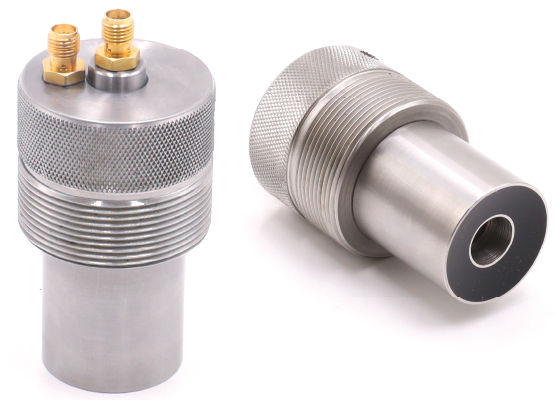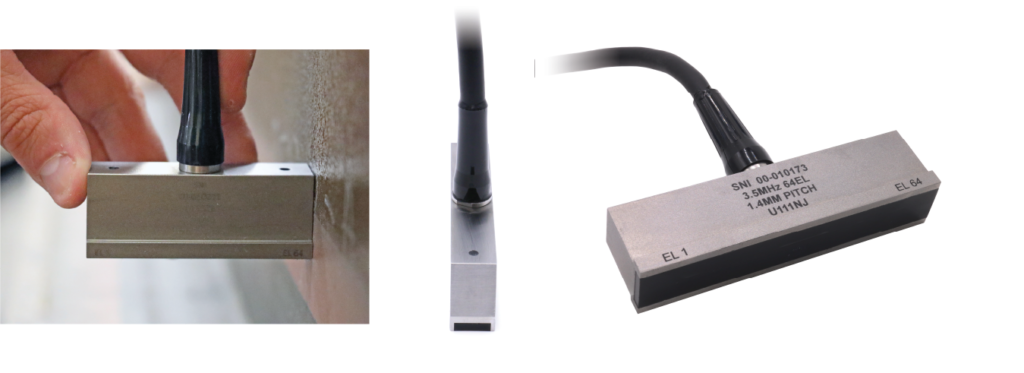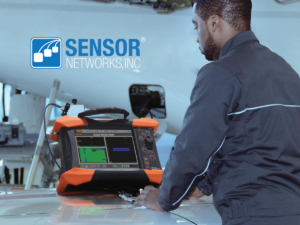Composite materials are increasingly being used in various industries due to their high strength-to-weight ratio, corrosion resistance, and durability. However, these materials are prone to defects due to manufacturing and environmental factors that can compromise their performance and structural integrity. Therefore, there is a need to test and evaluate the material both in the factory and in the field in order to maintain the highest level of safety, reliability, and quality.
Ultrasonic testing is a widely used nondestructive testing (NDT) method that utilizes high-frequency sound waves to detect and characterize defects in materials, including composites. This method works by sending ultrasonic waves through the material being tested and then measuring the waves that are reflected back. By analyzing the reflected waves, the thickness, composition, and structural integrity of the material can be determined.
The Advantages of Ultrasonic Testing and Array Transducers
One of the key advantages of ultrasonic testing is that it is non-destructive, meaning that it does not damage or alter the material being tested. This makes it an attractive option for testing expensive or irreplaceable components, as well as for inspecting parts that cannot be easily removed or replaced.
Array transducers are a particularly effective tool for inspecting composite materials due to their high-resolution imaging capabilities. They can detect smaller defects, such as cracking, porosity, inclusions, and delamination, and support a broad range of requirements and geometries. This proven and widely accepted imaging technology is fast and reliable, making it a valuable asset for diagnosing manufacturing issues on the factory floor and ensuring the quality, safety, and reliability of composite materials in a variety of industries

Major Disbond (Top View, Looking Down on the Structure)
Insufficient paste adhesive was applied in a zig-zag pattern. The red areas show a lack of bond. Subsequently, additional adhesive was applied to all components.

Delamination
The right half of the screen shows a clear path to the back surface while the left half shows a strong indication of delamination.

Rough Outer Surface
B-scan, cross-sectional view produced from a 5 MHz transducer providing higher resolution at the expense of penetrating power through to the back surface.
Explore Our Range of Transducers for Inspecting Composite Materials
At SNI, we bring deep domain expertise to enhance NDT solutions by selecting, designing, and optimizing the ultrasonic technique. We offer a range of options to help you inspect composite materials for defects and can also provide customized solutions tailored to your specific testing needs, including options for frequency, elements, pitch, cable length, and connectors.
1. The WheelArray is a valuable tool for a variety of industries that rely on composite materials for their products, such as aerospace, automotive, wind energy, and more. The WheelArray moves along the surface of composite materials and flat metal plates, using high-frequency sound waves to detect and characterize any internal defects. The data collected is analyzed to determine any defects, such as delaminations, voids, or disbonds. For more information about the WheelArray, view the datasheet.

2. Zero-Interface Probes (ZIP) are low-frequency delay-line transducers designed to inspect composite materials. The special delay lines used are acoustically matched to the composite material, which allows for a zero-interface signal, more efficient energy coupling and transmission, and increased near-surface resolution. ZIP probes are special delay-line contact probes that are single-element, longitudinal-wave (straight beam) transducers designed for the detection of near-surface flaws and thickness measurement of thin cross-section materials. Replaceable delay lines are available in packs of 5.


Echo of a ZIP Delay

Backwall Echo from a 0.14” (3.6mm) Composite Component with ZIP
3. Ultrasonic testing machines are offered by many Original Equipment Manufacturers (OEMs) to cover a wide variety of inspection applications including pipe, tube and bar, plate, and composite materials. This in turn requires transducers with a wide variety of physical and acoustic performance specifications. One unique example is the annular dual-frequency transducer which includes a low-frequency annular ring that surrounds a higher-frequency center transducer. This combination then enables near-surface detection of small defects combined with deeper penetration of heavier-wall sections.

4. The water-filled flexible membrane transducer maximizes the defect response on irregular entry surfaces, enhancing the ability to inspect irregularly shaped components with better penetration and resolution.
The current low-frequency models (1.5, 2.25, and 3.5 MHz) were designed to inspect carbon composite in the aerospace industry – but this technique is applicable to many other applications and materials.

The transducer is customizable for an easy and accurate inspection process. The membrane is replaceable and available in two materials – UltraFlex (for maximum conformability) and UltraWear (for maximum wear). The membrane can also be filled with water or Glycol liquid (for cold environments).
5. Immersion arrays are used in automatic and manual scanning systems using water or other liquids to couple to parts with complex geometries or large surface areas, making them effective for inspecting composite materials:

Curved arrays have a corrosion-resistant design and are waterproof up to 3.3 ft (1m) of water, making them highly reliable for testing machines. The array is designed to inspect the radius of curvatures ranging from ~ ¼” (6.35mm) to ~8” (200mm), making them perfect for the inspection of carbon-fiber-reinforced polymers (CFRP) corners.
Near Wall arrays allow for the inspection of 90-degree cross-sectional components. They are designed to provide high resolution and sensitivity in the near-surface region. By having the first element very close to the edge of the case, it is well suited for B- or C-scan imaging for defects such as cracking, porosity, inclusions, and delamination.

SNI has the experience and the capability to customize any transducer listed above and in this brochure. Customization includes:
- Frequency
- Element and transducer size and shape
- Array pitch and elevation
- Housing size and material
- Cable length and instrument connector
- OEM / Private Label
The growing use of composite materials across different industries highlights the need for effective testing and evaluation methods. At SNI, we provide a range of options for inspecting composite materials for defects, including customized solutions tailored to meet specific testing requirements. By utilizing ultrasonic testing using array transducers, industries can ensure the quality and reliability of their composite materials, ultimately resulting in safer and more efficient products.













